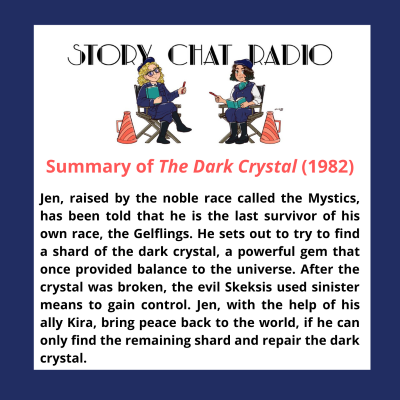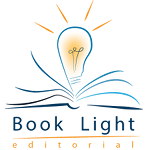Welcome to Story Chat Radio. We are book editors Carly Hayward and Jeni Chappelle. Every month we watch a different movie with an eye for storytelling and novel writing. We use our training and years of experience editing novels to break down each movie’s storytelling elements to help you improve your novel-in-progress. So no matter your path to publication or where you’re at in your publishing journey, Story Chat Radio can help you improve your writing.
On this week’s episode, we are discussing the 1980s Jim Henson film The Dark Crystal. And then we’ll end with a critique of one lucky author’s blurb.

Carly: What did you think about The Dark Crystal?
Jeni: It was weird watching this again after like 25 years. I picked up on a lot that I didn’t remember--and maybe never even knew. Like that the Skeksis should’ve looked like the Mystics because they were once the same race. I totally missed that before. I always thought they were some kind of bird, while the Mystics look like weird space mammals. It has a lot of common fantasy tropes like a prophecy with a chosen one and the old mentor dying but not passing on enough information for the main character to know what he’s doing. Dumbledore, anyone? It struck me that this is so common in kids’ fiction because this is how kids think of adults: we have all this information but are still somehow totally useless. What about you?
Carly: That’s such a good point about why it is so prominent in kids’ fiction. Although I was always the kid that just asked a million questions until I got enough info. I was always annoyed that Harry didn’t push for more information. Anyway, this was my first time watching The Dark Crystal. I had some expectations going into this, Labyrinth is one of my favorite movies and I knew this was another Jim Henson cult classic. And the visuals did not disappoint. I was all about the details and the artistry. Yes, some of the puppets were creepy, but that’s the charm! I could definitely see why people loved it, and I’m definitely going to jump into the new series. However, there was a lot I felt that was better in Labyrinth, besides David Bowie, which, duh. But overall, I could stare at this movie again and again.
Jeni: The most effective aspect of this movie to me was the worldbuilding, even though it sometimes employed techniques I’m not fond of, like voiceover. So the story starts with voiceover, explaining the history of the world and how it got the way it is now. It’s like the verbal equivalent of that Star Wars scroll, and the story actually starts with the villains instead of the hero. Fortunately it’s pretty short, like any good prologue, and it’s effective because it shows the stakes in a way that pulls the viewer in. Plus the Skeksis are just creepy AF. Like, kids’ movies today are so different than they were in the 80s. Anyway, in this case, the voiceover serves an important function in giving details as the visuals show the current plot. This is the equivalent of spreading important backstory and worldbuilding into breadcrumbs in the narrative of your first chapter so your reader stays oriented and knows what’s going on. I know you had some issues with some elements of the movie, but overall you enjoyed it, right?
Carly: I did have some problems. Let me preface this with: I really enjoyed the movie, and it is certainly successful. However, there was a lot that would not work in writing. To me the story was lacking. As you said, it has the chosen one trope. To be fair, this movie is what? Almost 40 years old? It’s not weird that it would have that trope. But, it didn’t take it far enough. You can do that trope and still make it new and interesting. That trope works when the main character is interesting, and Jen was a dud for me. Kira on the other hand, was amazing. She had this rich backstory full of heartache and peril, but most importantly she had and adorable dog-type sidekick, Fizzgig. I was obsessed with him. Had Kira been the chosen one, the main character, I think I would have been way more invested. Your main character should be interesting, not a cardboard cut-out for your plot to hang on. I wanted Jen to push the narrative and interact with the world in a more interesting way. And boy, was the world amazing. Like you said, a lot was filled in by the narrator in the beginning. It felt like an info-dump, but movies can get away with that. The rich world was filled in with unexpected visuals. Jim Henson shines with his amazing artistry, and there are definitely ways to put that into your writing. This movie really shows you how picking specific details and evocative words can really bring a world to life. You don’t need to spend paragraphs explaining the world if you find a unique and very specific detail that shows what the world is like.
Jeni: So, another aspect of the worldbuilding that struck me was the visual details, especially as the camera pans across the settings. I keep thinking about this one scene in the ruins and in the foreground, there’s a pile of stones. The one on the top has these engravings in it that really showcases the ancient and almost sacred feel of the ruins. This is such a great example of how writers need to decide which details to focus on in their worldbuilding. The camera can’t focus in on every single stone, or the movie would feel like some kind of weird puppet rock documentary. Just like in a book, an author can’t focus on every detail of their world. Authors need to ask how a detail fits in overall, what it tells the reader about the world, and why this particular detail is more important than others.
Carly: Exactly! I think the rookie mistake to make in world-building is filling your manuscript with unimportant details that flesh out the world. Of course those details are great. But each one needs to be special, or else why are we wasting time reading about it? Like you said, why is this detail important? What does it show about the world that is new or different? Does it show what your characters care about? What is telling about the detail that fleshes out both your world and your characters? Let’s take Aughra for example. Everything about her style and home shows us who she is and what matters to us. But it also shows us the state of the world they are living in. We know that people are living in rough times, magical times, and possibly lonely times. She has this amazing cosmology set-up that shows she is still holding out hope. But at the same time the rest of her house is full of defensive traps and her clothing shows that she’s getting harried and maybe has given up a bit. So while these details are amazing, they also serve to flesh out both the character and the state of the world.
Jeni: OK. This month, we have a back cover blurb critique for an Adult Fantasy manuscript. This story has parallel plotlines like The Dark Crystal. The movie alternates between showing what’s happening with the protagonist and what’s happening with the villains, while this story has a male main character and a female main character. Unlike The Dark Crystal, though, it looks like the male and female characters are equally compelling. I love the sense of humor in it this blurb. What did you think, Carly?
Carly: The humor was my favorite part too! Showing your voice in the blurb or query is the most overlooked tip. People get caught up on getting the facts out there and using “catching” words that they forget to include the voice of the manuscript. This definitely delivers on that. My only concern is that it doesn’t always follow through on the wry humor. It has a “tip” framing device where it says something along the lines of “Tip number one: women don’t like to be called wenches” which is great, but then we don’t get another tip. I felt like something was cut off or missing. Framing devices like this can add a lot of voice, but you need to find the balance between overdoing it and following through.
On our next podcast, we will be discussing the young adult film, To All the Boys I’ve Loved Before. Since this one is based on a book, we will only be talking about the storytelling in the movie, not the book. We will also have another query or blurb critique. If you want your query featured on the podcast, you can find the details about how to do that at our website.
You can also find our podcast on our website, storychatradio.com. Or you can follow us on Spotify or subscribe to Story Chat Radio on iTunes or Google Play Music. While you’re there, please leave us a rating. You can also follow us on Twitter and Instagram @StoryChatRadio.

